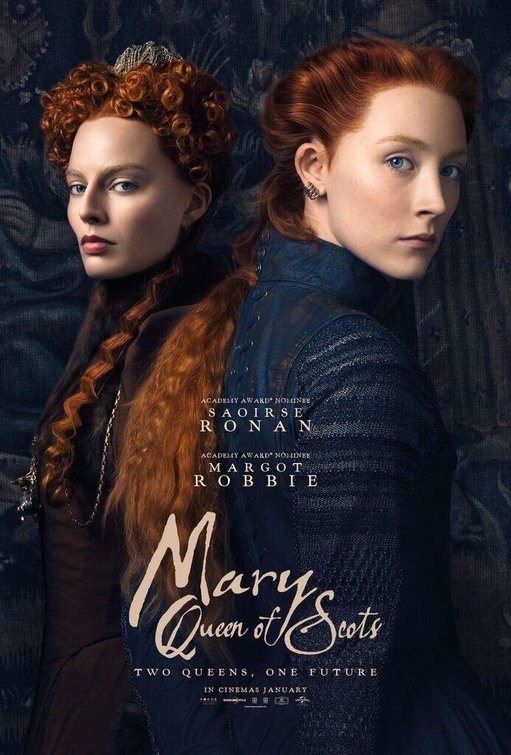Bow To No One.
Director
Josie Rourke
Starring
Saorise Ronan
Margot Robbie
Jack Lowden
Guy Pearce
Following the death of her husband, the Catholic Queen of Scotland Mary [Ronan], returned to her native land. Her cousin, the unmarried and heirless Protestant Queen of England, Elizabeth [Robbie], is threatened by her return and is advised by several politicians, earls, dukes and lords that they must act against any advancement to power made by Mary but constitutionally, Elizabeth is unable to directly involve herself without inciting open warfare. Elizabeth is advised by William Cecil [Pearce] to send a loyal English noble to wed Mary, thus enacting some control over her but Mary rejects Elizabeth’s choice and vies for the hand of Henry Stuart, Lord Darnley [Lowden]. Mary’s marriage to Darnley upsets the English who see this as an elevation of Mary’s right to the crown and the Scottish are suspicious of an Englishman sitting on the throne of Scotland.
Right from the outset, we need to discuss this feature’s finest components; the production design, hair and makeup and cinematography. The practical elements are astoundingly good and every scene is magnificently orchestrated and shot. All too often we take for granted the level of detail and work that goes into a production of this scale but the intricacy and craft is truly praiseworthy. Similarly, other than Logan, John Mathieson hasn’t been given a great deal to sink his teeth into that wasn’t slathered in CGI and with Mary Queen Of Scots, he finally gets to present an interesting dynamic, with Scotland’s blueish hues, covered in shadow and cloud, while England is presented with a warmer palate. I have no idea if this red against blue contrast (which mimics the nation’s respective flags) was intentional or not but it’s a nice touch either way.
Due to the script often lacking enough clout, the performances end up a bit of a mixed bag. Out in front we have Robbie and Ronan, both of whom do a spectacular job illustrating the struggles of a ruling female monarch who is surrounded by opportunistic chancers. Furthermore, both characters are presented in a fairly unique way, with Elizabeth transitioning to what she dubs “more man than woman” becoming a cold, calculating individual to survive and Mary is given a warrior’s prowess, abandoning the fairly soft-spoken representation we are all too familiar with. What’s more, mostly to date the lives of these queens has been told through the eyes and pens of male filmmakers and storytellers but there is a notably different feel with a female director at the helm, centring on the injustices inflicted upon these heads of state. This largely takes the form of sneering courtiers, red-faced with fury at the prospect of an upset status quo and incredibly weak, easily manipulated men. A prime example of the latter is Mary’s husband Henry, who is a spineless lush but given a considerable amount of power solely because of his gender and standing. As stated, the roles vary a little and a lot of the supports are neglected (a common complaint of any biopic) and unresolved, only to reappear to spout exposition. Curiously, Guy Pearce largely escapes that as William Cecil but he is also presented rather distinctly from other iterations; neither cold operator nor warm grandfather, he is presented as a loyal citizen who wants his country to excel seemingly above all personal interest.
Historical accuracy is going to be an interesting point of contention with release but let’s start with things the film seems to present well. Overall, I was rather impressed with the presentation and portrayal of court life; both Mary and Elizabeth are surrounded by two support struts, their council and their handmaidens. With the former, there is a clear resentment of female rule and an assumption that the monarch can be manipulated into puppetry and ultimately supplanted. As an interesting contrast to the controlling, conspiratorial nature of ambitious men, we have Elizabeth and Mary’s confidants. When Elizabeth is struck with the pox, her company of chamber maids seem unconcerned with infection and fiercely protect their queen. Likewise, Mary’s troupe are just as loyal, made up of Scottish, French and Italian individuals, one of whom being David Rizzio [Ismael Cruz Cordova], whose sexuality is addressed and welcomed by Mary: “be whoever you wish with us, you make for a lovely sister.”
But there are various developments that are rarely depicted on-screen which has left me wondering whether this film is ultimately revisionist or revelatory. As I have always maintained, for a work of entertainment, it doesn’t always matter. If you set out to create a living documentary, then so be it; if you want to make some bombastic fantastical feature that is more legend than history, that’s your choice. But historical films tend to pitch to a modern audience based on the expectations of the time. This is usually a given for action sequences, presenting fights that would seem underwhelming or sluggish are given a contemporary twist to elevate the scale and energy. This is also true for social politics and environmental factors; mostly an awareness of LGBTQ+ issues, bold religious opinions and respect for nature. Subsequently, Mary is presented as a very progressive and tolerant monarch. Now, whether this is in any way true or not is frankly impossible to know but as a device that serves to highlight the kind of impact Mary’s ideas would have had at the time, it is a decent narrative decision. Similarly, the presence of a more diverse cast of supporting roles is anachronistic because while there would have been a population of people of African or Asian descent in England, they certainly wouldn’t have been in such places of prominence in relation to the monarch. But again, is that at all important? I am of the same mindset as most contemporary Shakespearean productions – when casting, the right role should go to the right actor, regardless of ethnicity or gender.
Overall, this film boils down to a fairly hollow release. It contains fine performances, great levels of production and beautiful cinematography but the writing is pretty anemic and despite the new ground covered, the whole still feels like a re-tread. In a way, it has the air of the majority of films released directly to Netflix, that aren’t nearly as terrible as they could be but aside from a few thought-provoking aspects, are ultimately quite forgettable.
Release Date:
18th January 2019
The Scene To Look Out For:
**spoilers within**
With the pending birth of Queen Mary and Lord Darnley’s child worrying both English and Scottish lords, pressure is mounted on Darnley to blame Rizzio for the Queen’s alleged adultery and execute him. Rizzio is brutally murdered but Mary coerces Darnley to act and they leave the castle. Free from the hands of conspirators, Mary turns on Darnley and has him banished but will not divorce him. This entire section is fantastic cinema and a part of history that a great many people are probably unfamiliar with. Well-acted, well-executed and well-deserving of praise.
Notable Characters:
David Tennant portrays staunch Protestant cleric, John Knox; a man directly opposed to female rule and any form of Catholic subversion that may come with it. Stirring up inflammatory sentiment, he is one of the queen’s greatest nemeses. Yet all of his scenes effectively boil down to a strop in a castle courtroom and a handful of aggressive rants from the pulpit. Underusing this character is a missed opportunity but casting Tennant in such a villainous, antagonistic role and then underusing him is frankly shocking.
Highlighted Quote:
“When I am dead and you are dead and she is dead, what will it matter what names were or weren’t said?”
In A Few Words:
“A stimulating and refreshing historical drama lies deep within this film but there is far too much surface level inadequacy for it to properly shine”
Total Score: 3/5
![The Red Right Hand Movie Reviews [Matthew Stogdon]](https://reviews.theredrighthand.co.uk/wp-content/uploads/2021/12/cropped-header1.png)




